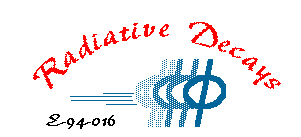

Radphi Video Conference 3/11/03
March 11, 2003
University of Connecticut
Storrs, CT
Present: R. Jones, M. Kornicer, D. Steiner, S. Teige,
D. Armstrong, E. Smith, D. Krop, D. Sober,
Theresa Conway.
NIM paper:
- link at
anthrax.physics.indiana.edu/~teige/nim.html
- Scott is going to release draft 1.0 by Monday Mar 17 and will
send around a note requesting comments. He will post an editorial
deadline like 10 days for changes from readers. Changes should
be referenced to a particular draft version.
LGD response studies from Monte Carlo:
- MK is doing a systematic comparison of the shower shape
in real data and Monte Carlo
http://zeus.phys.uconn.edu/~kornicer/radphi/psfp/#q7.
- He decided to compare shapes systematically based on polynomial
moments. This comparison showed some difference, particularly in
the kurtosis (4-th moment) along the transverse axis of the shower
(φ direction as opposed to r). He decided to study the
Cerenkov efficiency vs shower particle track angle to see if the
model is accurate. He found a strong dependency of efficiency on
shower track angle and so he switched on detailed Cerenkov tracking
to get as accurate a simulation as possible. Right now he has tried
different wrapping schemes and finds that the major differences are
in the shower statistics (i.e. energy resolution) rather than
shower shape.
- To get a better handle on shower energy resolution in real data,
we are putting together a selection of π° and η, ω
events from which energy resolution in the actual detector can be
deduced. From this, he will tune the Monte Carlo model by varying
the efficiency until it mimics the real data as well as possible.
After that, a new non-linearity correction will be created based
upon the Monte Carlo shower response.
Dan Steiner: progress on pass0
Dan Krop:
- The link is
http://dustbunny.physics.indiana.edu/~dkrop/2pi/0127
- At this web site his most recent PWA results on π°π°
are shown. He shows two consistency checks:
comparison of total acceptance-corrected yield from fit with
the H00 moment. Some questions were raised regarding the degree
of agreement seen and expected. Dan will replot this figure
on a log scale to facilitate comparison. The other check was a
sum rule on the normalized moments. This was working.
- He then compared the S-wave yield from PWA in the case with and
without boot-strapping. Boot-strapping is the practice of using
the solution from one mass point as the starting value in the fit
of an adjacent bin. It tends to keep ambiguities in the solutions
from jumping between choices across a small kinematic interval.
Over longer intervals, the chance of a jump is bigger. To understand
this Dan is studying a general scheme for chosing between ambiguous
solutions.
As soon as this is done he will provide a plot of the S-wave yield
and S/D0 interference across the range of our mass acceptance.
Next meeting: Tuesday March 18, (9:30) 10:00-11:00.
This page is created by
Mihajlo Kornicer



